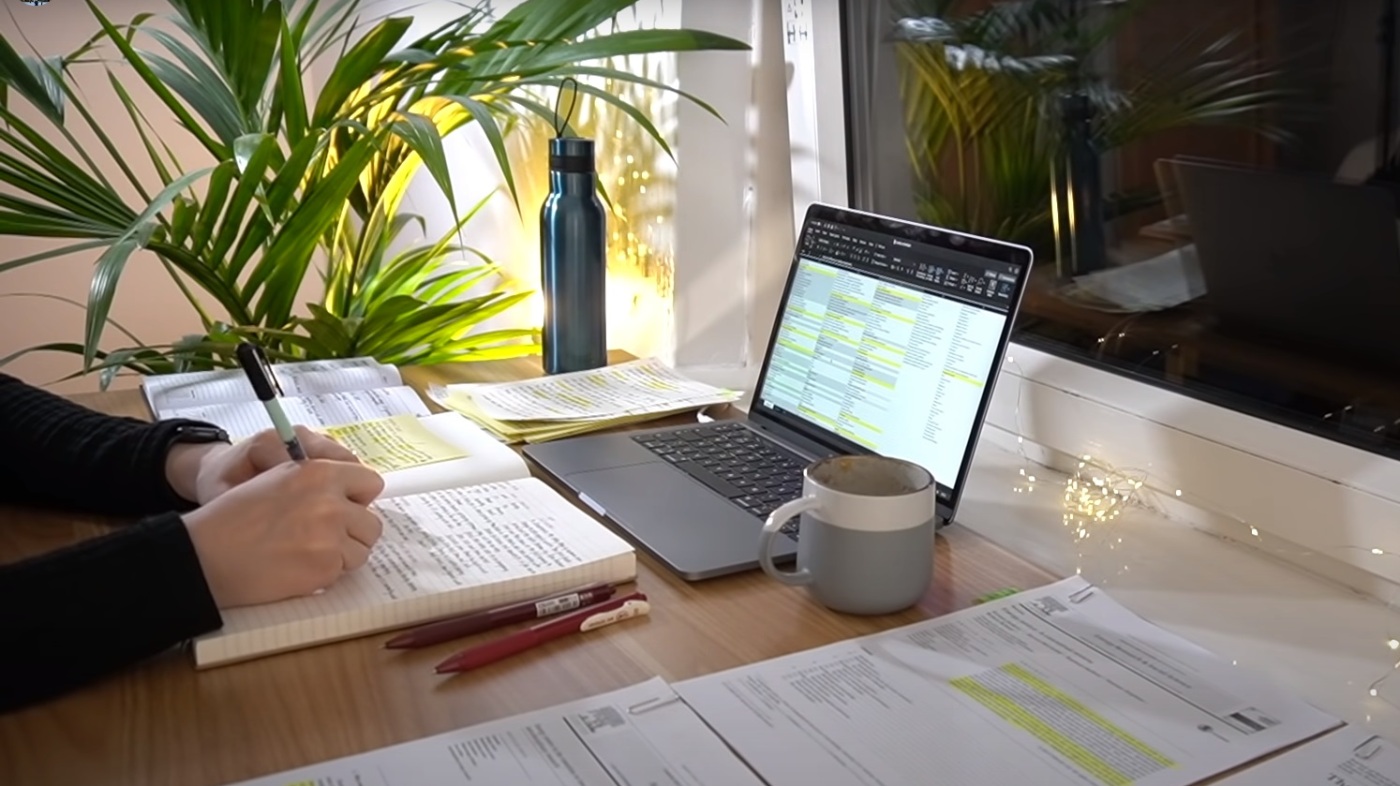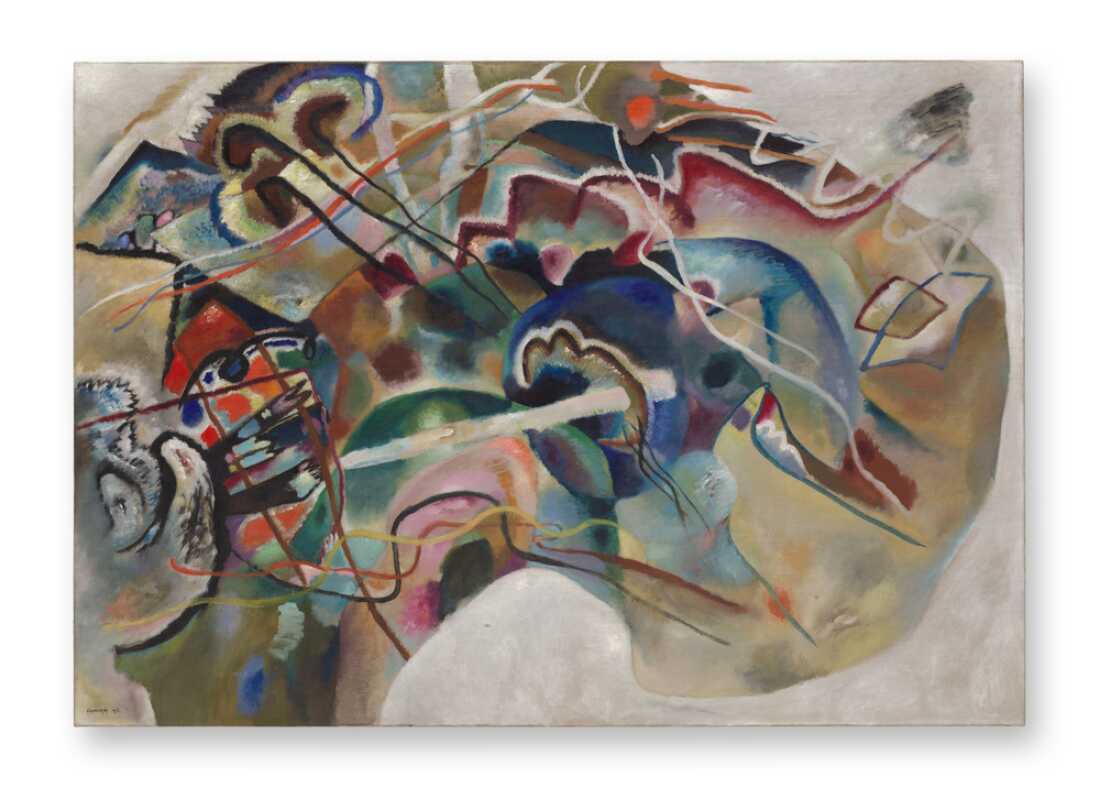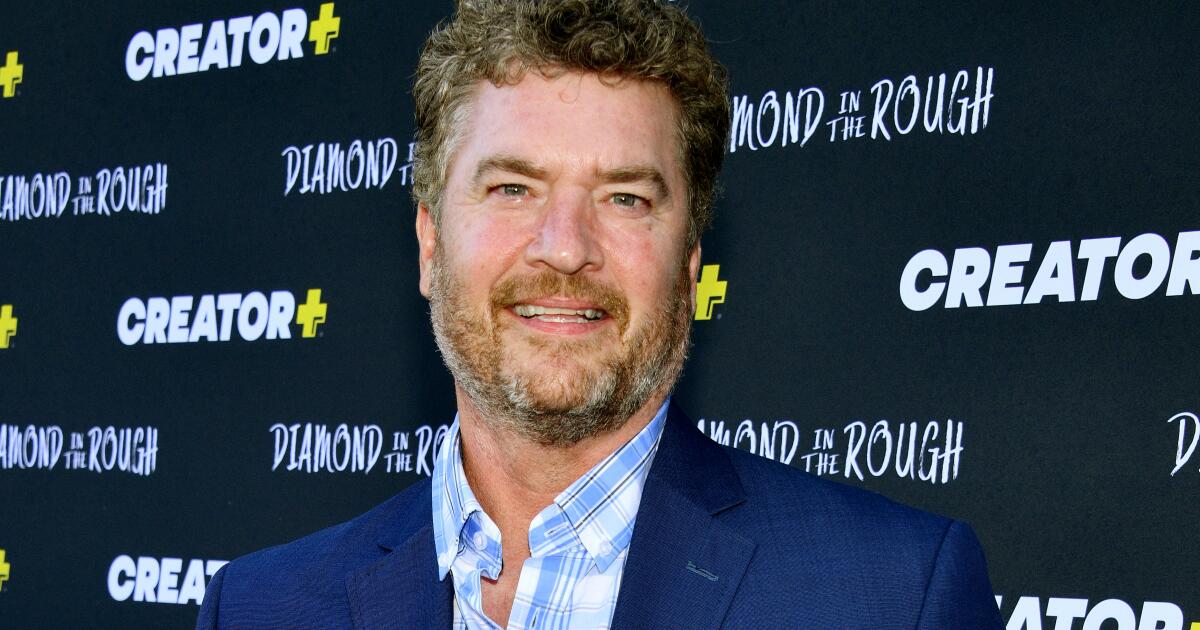Lifestyle
Come study with me: How a virtual buddy might help you get things done

On YouTube, creators are filming themselves studying, working or cleaning in real time — it helps the creators stay focused and encourages their viewers too.
YouTube
It’s no secret that we live in an age of near-constant digital distractions. Between texts, direct messages, push alerts and other diversions and interruptions, it can be really hard to focus and get stuff done.
However, some folks are using their digital devices to increase their focus and productivity — borrowing a technique often used by people with ADHD. Real-time videos of people studying, working or cleaning are getting tens of millions of views.
Back when Jen Simon of South Orange, N.J., was a teenager, she and her sister both struggled with getting things done.
“My mom figured out my sister had undiagnosed ADHD,” Simon says, “and she figured out some hacks — before they were called hacks — to work with my sister. When she had to do something like clean her room or put away her clothes or whatever it was, my mom would sit with her. She would sit with me often too.”
A few months back, Simon found herself with a load of paperwork she had been putting off. She recalled her mom’s technique and put out a call on Facebook asking for a friend or two to do the same: just come sit with her as she tackled her mission.
It was then that Simon learned that her mom’s old hack now has a name: body doubling. “It works really well for me,” Simon says. She now uses it with her own kids too.
The magic of another person’s presence
Experts say that body doubling is a really effective technique. Even if someone is just sitting nearby doing their own thing while we are working, it seems to spark us into action.
Dr. Edward Hallowell is a psychiatrist and the author of more than 20 books, many of them about attention-deficit/hyperactivity disorder.
“People with ADHD find body doubling unusually helpful because we — I have the condition myself — we respond magically to the presence of another person,” he says. “Just having another person nearby activates a kind of attention, imagination, creativity, that is dormant when we’re all by ourselves, usually.”
Body doubling has become wildly popular among folks with ADHD and those who struggle with what professionals call “executive functioning” — the many mental steps we all go through to plan, focus on tasks and accomplish our goals.
(According to the Centers for Disease Control and Prevention, an estimated 7 million children in the U.S. between the ages of 3 and 17 had been diagnosed with ADHD as of 2022; a global study published in 2023 estimates that about 3% of adults worldwide live with ADHD.)

Author Jessica McCabe, creator of the popular YouTube channel How to ADHD.
Anastasia Tsioulcas/NPR
hide caption
toggle caption
Anastasia Tsioulcas/NPR
Author Jessica McCabe runs a popular YouTube channel called How to ADHD. She also calls body doubling an effective strategy.
For example, McCabe says, “I stayed with a friend who has ADHD and who was really struggling to clean her house. So we played a game. I would hold up a couple of items, and she was the one who had to decide where it would go. But I would give her choices: ‘Should this go in the kitchen, under the sink? Should this go in your bedroom, in a drawer? Should it go on top of my head?’”
It was very playful, McCabe says, but it still helped her friend break things down.
“Before, she was really overwhelmed at the prospect of trying to figure out where things went,” McCabe observes, “because there were just too many cognitive steps. Splitting that cognitive load can be incredibly helpful and make tasks that were a real challenge easy for us.”
McCabe says this is active body doubling — having someone participate in your task. But there’s passive body doubling too — like Simon’s mom sitting with her. In a funny way, many of us have practiced this for years. Maybe you go to a coffee shop to get some work done, or you go to a library to study: All those people sitting around you in those public spaces are kind of unwitting witnesses to your productivity.
Online, alone together
Online, people are creating and finding that kind of accountability. Websites and apps now help you find a task buddy. But there’s an even more popular avenue for finding a virtual body double, either pretaped or live: YouTube videos.
On YouTube, many creators are filming themselves studying, working or cleaning in real time; think of their videos as a friend who’s always up for the grind. McCabe says that these videos can provide a gentle form of accountability for the creators.
“If you don’t do the thing, people will know,” she says. “And if you do do the thing, people will know. So you get a little bit of dopamine hit even from that, even from just going, ‘I’m doing a good job and somebody knows that I’m doing a good job.’”
McCabe says this works not just for the person who made the video but also for the people who use the video.
“The person who’s doing the video is not going to know if you’re actually cleaning or not. But there’s still this gentle social pressure of, ‘Oh, I see somebody cleaning. I feel like I should also be cleaning.’”
She says these virtual sessions probably aren’t quite as effective as getting together for real, but they are useful in certain situations: if you have an odd schedule, for example, or if you’re suddenly seized with the energy to tackle something you’ve been ducking, or if you deal with social anxiety. “You might not feel comfortable asking somebody in real life to body-double with you,” she says. “And then it can be really powerful.”
YouTube
These body-doubling videos — at least hundreds of them are on YouTube — are cumulatively racking up tens of millions of views.
Hallowell says that even though screen usage can of course be isolating, paradoxically, this kind of creative use of videos might just knit us closer together.
“We live in an age of loneliness,” Hallowell observes. “It’s so paradoxical because we’re connected electronically like never before, but we’ve been disconnecting interpersonally. If you create yourself an audience, even though it’s invisible and online, that makes you feel less lonely. That’s very energizing.”

“It’s not just accountability — it’s imagining an audience,” he adds. “When I write books, I have an audience in mind. And that makes me do much better than if I was just writing for the darkness of the universe.”
Both McCabe and Hallowell say that the technique of body doubling — whether in person or virtual — can help all kinds of people, not just those who have been diagnosed with ADHD and executive-functioning issues.
In an era when we all tend to be at least a little bit distracted a lot of the time, body doubling can help keep us all on track. And maybe try turning off all those phone alerts too.

Lifestyle
Sunday Puzzle: P-A-R-T-Y words and names

On-air challenge
Today I’ve brought a game of ‘Categories’ based on the word “party.” For each category I give, you tell me something in it starting with each of the letters, P-A-R-T-Y. For example, if the category were “Four-Letter Boys’ Names” you might say Paul, Adam, Ross, Tony, and Yuri. Any answer that works is OK, and you can give answers in any order.
1. Colors
2. Major League Baseball Teams
3. Foreign Rivers
4. Foods for a Thanksgiving Meal
Last week’s challenge
I was at a library. On the shelf was a volume whose spine said “OUT TO SEA.” When I opened the volume, I found the contents has nothing to do with sailing or the sea in any sense. It wasn’t a book of fiction either. What was in the volume?
Challenge answer
It was a volume of an encyclopedia with entries from OUT- to SEA-.
Winner
Mark Karp of Marlboro Township, N.J.
This week’s challenge
This week’s challenge comes from Joseph Young, of St. Cloud, Minn. Think of a two-syllable word in four letters. Add two letters in front and one letter behind to make a one-syllable word in seven letters. What words are these?
If you know the answer to the challenge, submit it below by Wednesday, December 31 at 3 p.m. ET. Listeners whose answers are selected win a chance to play the on-air puzzle.
Lifestyle
L.A. Affairs: We were just newlyweds when an emergency room visit tested our vows

“I’m his wife,” I said to the on-call doctor, asserting my place in the cramped exam room. It was a label I’d only recently acquired. A year ago, it had seemed silly to obtain government proof of what we’d known to be true for six years: We were life partners. Now I was so grateful we signed that piece of paper.
Earlier that morning, I’d driven my husband to an ER in Torrance for what we’d assumed was a nasty flu or its annoying bacterial equivalent. We’d imagined a round of industrial-grade antibiotics, and then heading home in time for our 3-year-old’s usual bath-time routine.
But the doctor’s face was serious. Machines beeped and whirred as my husband laid on the hospital bed. Whatever supernatural power colloquially known as a “gut feeling” flat-lined in my stomach.
“It’s leukemia,” she said, putting a clinical end to what had been our honeymoon period.
Only six months earlier, a female Elvis impersonator had declared us husband and wife. A burlesque dancer pressed her cleavage into both of our faces as our friends cheered and threw dollar bills. A wedding in Vegas was my idea.
After two years of dating Marty, a cute roller hockey player with an unwavering moral compass, I knew I wanted to have a child with him. It was marriage, not commitment, that unnerved me. I wanted romance, freedom and to do things my way. The word “wife” induced an allergic reaction.
As Marty and I became parents and navigated adulthood together, my resistance to matrimony started to feel like an outdated quirk. The emotional equivalent of a person still rocking a septum piercing long after they stopped listening to punk music.
Marty had shown me, over and over, what it was to be a teammate. He’d rubbed my back through hours of labor, made late-night runs for infant Tylenol and was never afraid to cry at the sad parts of movies or take the occasional harsh piece of feedback about his communication style. And like all good teams, we kicked ass together. So why was I still resisting something that meant so much to him? To our family?
One random Saturday, at the Hawthorne In-N-Out Burger, after Marty ordered fries as a treat for our son, I finally said, “Screw it. Let’s get married.”
The wedding day was raucous and covered in glitter. We both wore white. Our son’s jacket had a roaring tiger stitched onto the back and was layered over his toddler-size tuxedo T-shirt. Loved ones from all over the country flew to meet us in a tiny pink chapel. A neon heart buzzed over our heads as we vowed to “love each other in sickness and in health, till death do us part.”
I couldn’t have imagined then that the next chapel I’d be in would be the hospital prayer room. Or that I would have begged a God I struggle to believe in to please spare Marty’s life.
Unlike our decision to marry, acute leukemia came on suddenly. Over the course of a few weeks, Marty’s bone marrow had flooded his blood with malignant cells. Treatment was urgent. He was taken by ambulance from the ER to the City of Hope hospital in Duarte, a part of Los Angeles County we’d never had a reason to visit before.
Traditionally the 50th wedding anniversary is celebrated with gold, the 25th with silver and the first with paper. But we couldn’t even afford to look paper-far-ahead anymore. Instead, we celebrated that the specific genetic modifiers of Marty’s cancer were treatable, the good chemo days and his being able to walk to the hospital lobby to see our son for the first time in weeks.
Leukemia has taught me things such as: how to inject antifungal medication into the open PICC (peripherally inserted central catheter) line in Marty’s veins, how to explain to our son that “Papa will be sleeping with the doctors for a long while so they can help him feel better” and that to do the hibbity-dibbity with a person going through chemo, you must wear a condom. But mostly my husband’s sickness has taught me about healthy love.
When we had a child together, we’d committed to being in each other’s lives forever. But marriage was different. We’d already made a promise to our son, but when we got married, we made one to each other and ourselves. We had gone all in.
Since his diagnosis two months ago, there have been so many ways we’ve shown love for each other. People assume that I would do all the caregiving, but it’s more than that. Yes, I’ve washed my husband’s feet when he couldn’t bend down, been the only parent at preschool dropoff and pickup, and advocated on Marty’s behalf to his health insurance with only a few choice expletives.
But my husband has also taken care of me. Even when he was nauseous, sweating and fatigued, Marty showed up. He made me laugh with macabre jokes about how the only way for us to watch anything other than “PAW Patrol” on TV together was for him to get hospitalized. He insisted that I make time to rest and bring him the car owner’s manual, so he could figure out why the check engine light had come on.
We’d promised in front of our closest friends and Elvis herself to love each other “for better or worse.” And when the worst arrived sooner than expected, we did more than love. We truly cared for each other as husband and wife.
The author is a writer whose short stories have been nominated for the PEN/Robert J. Dau Short Story Prize for Emerging Writers and Best of the Net. She is working on a novel and lives in Redondo Beach with her husband and son. She’s on Instagram: @RachelReallyChapman.
L.A. Affairs chronicles the search for romantic love in all its glorious expressions in the L.A. area, and we want to hear your true story. We pay $400 for a published essay. Email LAAffairs@latimes.com. You can find submission guidelines here. You can find past columns here.
Lifestyle
This painting is missing. Do you have it?

The missing 1916 painting Music, by Gabriele Münter. Its whereabouts have been unknown to the public since 1977. Oil on canvas. (Private collection. © 2025 Artists Rights Society (ARS), New York/VG Bild-Kunst, Bonn)
The Guggenheim, New York
hide caption
toggle caption
The Guggenheim, New York
This is a story about a missing painting, from an artist you may never have heard of. Though she helped shape European modern art, German artist Gabriele Münter’s work was quickly overshadowed in the public’s mind by her 12-year relationship with noted abstract artist Wassily Kandinsky.
She met Kandinsky in Munich in 1902, and with his tutoring, she “mastered color as well as the line,” she told a German public broadcaster in 1957. Together with other artists, they founded an avant-garde arts collective called Der Blaue Reiter (The Blue Rider) in 1911.

Wassily Kandinsky’s Painting With White Border (Bild mit weißem Rand), 1913. Oil on canvas, Guggenheim Museum, New York City.
Allison Chipak/The Guggenheim, New York
hide caption
toggle caption
Allison Chipak/The Guggenheim, New York
At the time, most modern artists, like Kandinsky, were moving toward more and more abstract work. Not Münter. In her paintings, people look like people and flowers look like flowers. But her dazzling colors, simplified forms and dramatic scenes are startlingly fresh; her domestic scenes are so immediate that they feel like you’ve interrupted a crucial, private moment.
“Gabriele Münter was so pioneering, so adventurous in her adherence to life,” said Megan Fontanella, curator of modern art and provenance at the Guggenheim Museum in New York City. “She is revitalizing the still life, the landscape, the portrait genres, and presenting them in these really fresh and dynamic ways.”
Yet, perhaps due to her relationship with Kandinsky, her work was rarely collected by important museums after her death in 1962 (she herself said she was seen as “an unnecessary side dish” to him), and so her paintings largely disappeared from the public eye.
Now Münter is having a moment, with exhibitions this year in Madrid and Paris, as well as one currently at the Guggenheim in New York. The New York show is an expansive one and includes American street photography in the late 1890s, alongside over 50 paintings, from her dazzlingly colored European landscapes to portraits capturing the expressive faces of people she knew.

Gabriele Münter’s Self-Portrait in Front of an Easel (Selbstbildnis vor der Staffelei), circa 1908-1909. Oil on canvas. (© 2025 Artists Rights Society (ARS), New York/VG Bild-Kunst, Bonn)
Bruce M. White/Princeton University Art Museum/Art Resource, N.Y.
hide caption
toggle caption
Bruce M. White/Princeton University Art Museum/Art Resource, N.Y.
Yet, when Fontanella was putting “Gabriele Münter: Contours of a World” together, there was one painting she couldn’t find: Music, from 1916.
In it, a violinist is playing in the center of a yellow room, with two people quietly listening. It’s set in a living room — but because it uses her wild colors and flattened figures, it feels vibrant and dramatic, not cozy or saccharine.
Fontanella said this painting is important because it provides a window into Münter’s life after she separated from Kandinsky, who had gone on to marry someone else. She was struggling financially, and she was no longer the promising young person she once was. But Fontanella said the painting shows she had found a new creative circle.
“There’s something really uplifting about that. You know, it speaks to her resilience, her sense of adaptation,” Fontanella said. Instead of showing those years as dark and challenging, it is serene and warm, joyful. “I think that’s really important because especially with a woman artist, it’s so easy to get tripped up in her biography and really see it colored by her romantic relationships when, in fact, the paintings tell a different story.”
Fontanella said she used every tool available to her to find Music. She worked with Münter’s foundation and contacted owners of collections in Europe and the United States, from institutions to private collectors. She read correspondence and catalogs from past exhibitions.

Gabriele Münter’s From the Griesbräu Window (Vom Griesbräu Fenster), 1908. Painting on board. (© 2025 Artists Rights Society (ARS), New York/VG Bild-Kunst, Bonn)
Städtische Galerie im Lenbachhaus und Kunstbau München, on permanent loan from the Gabriele Münter and Johannes Eichner Foundation, Munich
hide caption
toggle caption
Städtische Galerie im Lenbachhaus und Kunstbau München, on permanent loan from the Gabriele Münter and Johannes Eichner Foundation, Munich
It’s not unusual for art to vanish from public view if it’s not held at an institution. Private collectors often want to keep their holdings quiet. If they don’t sell a particular work at an auction or lend it to a museum, only a very small number of people might know that it still exists and where it is.
Fontanella was able to trace Music to its last known owner — a German collector named Eugen Eisenmann, who had the painting in 1977.
“There was a moment where the collection was starting to be broken apart and dispersed and no longer being held by subsequent relatives or family members,” she said.
Then the trail ended.
Not the end of the story
But just because the painting hasn’t surfaced yet doesn’t mean it never will. Take the story of a piece called There are combustibles in every State, which a spark might set fire to. —Washington, 26 December 1786, depicting Shays’ Rebellion, one of 30 works in the Struggle series by artist Jacob Lawrence. A 2020 traveling exhibition organized by the Peabody Essex Museum in Salem, Mass., had brought the works together for the first time in 60 years.
Five of the paintings couldn’t be located, and the curators put placeholders where those paintings should have been: black-and-white photographs of the canvases if they existed, blank spaces if they didn’t.
“We didn’t have any image of it. There really was no trace,” said Sylvia Yount, the curator in charge of the American Wing at the Metropolitan Museum of Art. She co-curated the Met’s presentation of the exhibition with curator Randall Griffey. “We had decided to leave the missing panels as kind of an absence, to really underline the absence. There was a blank on the wall.”
And, then, the miracle.
A visitor to the exhibition went home, contacted a friend “and said, ‘I think you might have one of these missing panels,’” Yount explained.
The friend did. When Yount, Griffey and art conservator Isabelle Duvernois went to see the painting — which was just across Central Park from the Met in an apartment on the Upper West Side — “we walked in and immediately knew it was right,” Yount said.
Within about two weeks, it was hanging in the exhibition. Incredibly, not long later, a second panel was found. Because that one needed some conservation work and a new frame, it didn’t join the series at the Met, but it did become part of the show later as it traveled across the United States.
That kind of thing “doesn’t happen every day,” Yount said, laughing.
Could it happen again?
But Fontanella hopes that it could happen for Münter’s painting. She included a photograph of it in the catalog so that people would know what to look for.
“What I always hope with stories like this is that the painting will resurface in its own time, you know, when it wants to be discovered,” Fontanella said. “But there’s been so much genuine interest in Gabriele Münter as an artist, as a person, that I feel it’s only just on the horizon that this painting will come to light.”
“Gabriele Münter: Contours of a World” is on view at the Guggenheim in New York through April 2026.
Ciera Crawford edited this story for broadcast and digital. Chloee Weiner mixed the audio.
-

 Entertainment4 days ago
Entertainment4 days agoHow the Grinch went from a Yuletide bit player to a Christmas A-lister
-

 Connecticut4 days ago
Connecticut4 days agoSnow Accumulation Estimates Increase For CT: Here Are The County-By-County Projections
-

 Entertainment5 days ago
Entertainment5 days agoPat Finn, comedy actor known for roles in ‘The Middle’ and ‘Seinfeld,’ dies at 60
-

 Milwaukee, WI5 days ago
Milwaukee, WI5 days ago16 music and theater performances to see in Milwaukee in January 2026
-

 World1 week ago
World1 week agoPutin says Russia won’t launch new attacks on other countries ‘if you treat us with respect’
-

 Indianapolis, IN2 days ago
Indianapolis, IN2 days agoIndianapolis Colts playoffs: Updated elimination scenario, AFC standings, playoff picture for Week 17
-

 Southeast3 days ago
Southeast3 days agoTwo attorneys vanish during Florida fishing trip as ‘heartbroken’ wife pleads for help finding them
-

 World3 days ago
World3 days agoSnoop Dogg, Lainey Wilson, Huntr/x and Andrea Bocelli Deliver Christmas-Themed Halftime Show for Netflix’s NFL Lions-Vikings Telecast


















